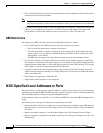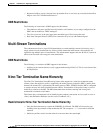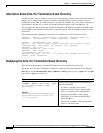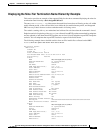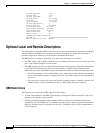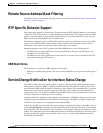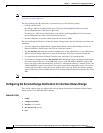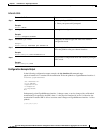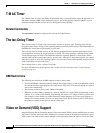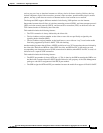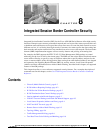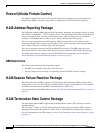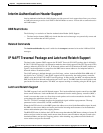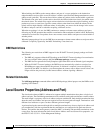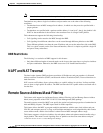
7-14
Cisco IOS XE Integrated Session Border Controller Configuration Guide for the Cisco ASR 1000 Series Aggregation Services Routers
OL-15421-01
Chapter 7 H.248 Services—Signaling and Control
T-MAX Timer
T-MAX Timer
The T-MAX timer is a timer that limits the maximum delay of retransmissions by the H.248 stack on a
data border element (DBE) when sending messages to the media gateway controller (MGC) over an
unreliable transport media (such as the User Datagram Protocol [UDP]).
Related Commands
The tmax-timer command configures the value of the T-MAX timer.
The tsc-Delay Timer
The tsc-delay timer is a timer used to delay entry into the tsc-quiesce state. Delaying entry into the
tsc-quiesce state delays closing all the signaling pinholes gracefully and delaying a TerminationState of
OutOfService, where the tsc/gtd property is set to ON.
The tsc-delay timer is started when an H.248 Subtract command deletes the final termination from a
context that does not have the tsc/gtd property set to ON. This delay provides a window during which
closing SIP messages can flow to the endpoints before the signaling pinhole is closed by the media
gateway (MG) and the context enters the tsc-quiesce state. After the tsc-delay timer expires, the context
enters the tsc-quiesce state, the signaling pinhole is closed, and (if subscribed) the MG generates H.248
event notifications for the tsc/dc event.
The tsc-delay timer is set to a value of 2 seconds.
For more information on the tsc-quiesce state, see the “H.248 Termination State Control Package”
section on page 6-4.
DBE Restrictions
The following are restrictions of DBE support for the tsc-delay timer:
• If an H.248 Modify command explicitly changes the tsc/gtd property so that all terminations within
the context have the tsc/gtd property set to ON, the tsc-delay timer is not started, and the tsc-quiesce
state occurs immediately.
• The duration of the tsc-delay timer cannot be modified.
• While the tsc-delay timer is running for a context, the MG can accept further programming for that
context. If, as a result of this interim programming, the context is no longer in the tsc-quiesce state
(for example, if new streams are added without the tsc/gtd property set, or the tsc/gtd property is
changed for existing streams), then the tsc-delay timer stops, and no further action is taken unless
the context re-enters the tsc-quiesce state at a later time.
Video on Demand (VOD) Support
Integrated Session Border Controller supports video on demand (VOD) systems, enabling users to select
and watch or listen to video and audio content over a network as part of an interactive television system.
VOD systems can either stream content through a set-top box that allows the user to view in real time,



